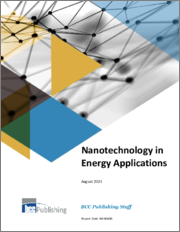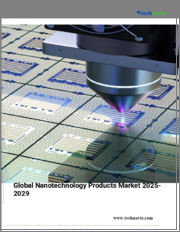
|
시장보고서
상품코드
1308032
세계의 에너지 산업용 나노기술Nanotechnology in Energy Applications |
||||||
세계의 에너지 산업용 나노기술 시장 규모는 2023년 93억 달러에서 예측 기간 동안 15.0%의 CAGR을 나타내고, 2028년에는 188억 달러 규모로 성장할 것으로 예상됩니다.
북미는 2023년 26억 달러에서 연평균 14.2%의 성장률을 보이며 2028년 51억 달러 규모로 성장할 것으로 예상됩니다. 아시아태평양은 2023년 38억 달러, 2023년 60억 달러에서 18.0%의 CAGR로 2028년 88억 달러 규모로 성장할 것으로 예상됩니다.
세계의 에너지 산업용 나노기술(Nanotechnology) 시장을 조사했으며, 시장 개요, 시장 영향요인 및 시장 기회 분석, 시장 규모 추이 및 예측, 각 부문별/지역별 상세 분석, 신기술 및 개발 동향, 특허 동향, 경쟁 구도, 주요 기업 개요 등의 정보를 정리하여 전해드립니다.
보고서에 포함된 내용:
- 세계 에너지 산업용 나노기술 시장의 상세한 개요와 최신 분석
- 시장 수익 데이터 추정, 예측, CAGR, 시장 동향
- 현재 시장 규모 추정 및 예측, 시장 점유율 분석 : 소재별, 용도별, 지역별
- 에너지 생산 또는 에너지 절약 응용 분야의 각 나노 스케일 재료 및 장치 시장의 잠재력 특성화 및 정량화, 상업적 성공을 위한 주요 요구 사항 파악
- 제품 수요를 촉진하는 요인에 대한 고찰과 에너지원 및 지역별 동향, 잠재적 매출, 예측
- 현재 상업적으로 이용되고 있거나 2028년까지 상업화될 수 있는 나노기술 응용 분야 파악
- 나노 스케일 재료 및 장치가 세계 에너지 수지에 미치는 잠재적 영향 추정
- 에너지산업용 나노기술에서 ESG의 중요성, ESG 이행의 주요 과제, 기업의 표준적인 ESG 실천, 에너지산업용 나노기술의 ESG 고려 현황과 미래 전망
- 주요 특허 부여 검토, 세계 시장에서의 새로운 전개
- 최근 인수, 제휴, 합의, 협력 및 기타 전략적 제휴에 관한 최신 정보
- 주요 이해관계자 파악 및 기업 경쟁 구도 분석 : 최근 전개, 재무 실적, 부문별 수익, 사업 통합 등
- 주요 기업 프로파일: A123 Systems LLC, The Chemours Co., Honeywell International Inc., Nanosolar Inc., Solaronix 등
Highlights:
The global nanotechnology in energy applications market should reach $18.8 billion by 2028 from $9.3 billion in 2023 at a compound annual growth rate (CAGR) of 15.0% for the forecast period of 2023 to 2028.
North American nanotechnology in energy applications market is expected to grow from $2.6 billion in 2023 to $5.1 billion in 2028 at a CAGR of 14.2% for the forecast period of 2023 to 2028.
Asia-Pacific nanotechnology in energy applications market is expected to grow from $3.8 billion in 2023 to $8.8 billion in 2028 at a CAGR of 18.0% for the forecast period of 2023 to 2028.
Report Scope:
This report examines nanotechnology in energy industry applications. Definitive and detailed estimates and forecasts of the global market are provided, followed by a detailed analysis of the nanomaterials, energy application and regions. Ongoing market trends, growth drivers and challenges impeding the market are discussed. The report will analyze global nanotechnology in energy markets by material, applications and geography. It will also focus on the regulations and government-supported programs impacting this market. Regionally, the focus of study will be the markets of North America, Europe, Asia-Pacific, and the Rest of the World (RoW).
The report focuses on the global market for nanoscale materials (e.g., nanopowders, nanocomposites, nanoscale thin films, and others) and devices (e.g., nanosensors) used in renewable and nonrenewable energy production (e.g., petroleum refining, solar energy) and energy storage (e.g., batteries and fuel cells). In the other types of applications (e.g., energy transmission, energy conversion, energy end uses), nanotechnology consumption is almost negligible.
The report concentrates on nanotechnology applications that are currently in commercial use or are likely to be commercialized by 2028. Other applications that, while promising, are not likely to make it out of the laboratory by 2028, are not covered in depth. It is worth noting that, unlike the previous versions of this report, these figures do not include consumption of industrial enzymes, as enzymes are not included in most assessments of the overall nanomaterials market.
The report does not cover nanoscale materials and devices used to monitor and/or control the environmental impacts of energy production or uses such as nanomaterials in automotive catalytic converters. These technologies are outside the scope of this study and are covered in detail in several other BCC Research reports such as report NAN039C, Nanotechnology in Environmental Applications.
Using 2022 as the base year, the report provides estimated market data for the forecast period from 2023 to 2028. The market size for different regions (regions by application) will also be covered. The impact of COVID-19 was also considered when deriving market estimations. Sales value estimates are based on prices in the supply chain. Market-driving forces and industry structure are examined. International aspects are analyzed for all global regions.
In 2020, the growth rate of global manufacturing industries was severely affected by the COVID-19 pandemic. The pandemic halted progress in every regional economy. Governments took measures to contain the economic slowdown.
Report Includes:
- 33 tables and 62 additional tables
- Detailed overview and an up-to-date analysis of the global market for nanotechnology in energy applications
- Analyses of the global market trends, with market revenue (sales figures) for 2022, estimates for 2023, and projections of compound annual growth rates (CAGRs) through 2028
- Estimation of the actual market size and revenue forecast for global nanotechnology in energy applications market, and corresponding market share analysis based on material, application, and region
- Characterization and quantification of the market potential for each short-listed nanoscale materials and devices used in energy production or conservation applications, and identification of the main prerequisites that are still under development for commercial success
- A look at various factors involved in driving product demand in conjunction with trends, potential sales, and forecasts for major energy source markets and specific geographical markets
- Identification of nanotechnology applications that are currently in commercial use or are likely to be commercialized by 2028
- Estimation of potential net impact of nanoscale materials and devices on the global energy balance
- Detailed understanding of the importance of ESG in the nanotechnology in energy industry, key issues in implementing ESG principles, standard ESG practices by companies, as well as the current status and future of ESG considerations in nanotechnology for energy applications
- Review of key patent grants on nanotechnology applications in energy sector, and new and emerging developments in the global market
- Updated information on recent industry acquisitions, partnerships, agreements, collaborations, and other strategic alliances in the global nanotechnology in energy applications market
- Identification of major stakeholders and analysis of the company competitive landscape based on their recent developments, financial performance, segmental revenues, and operational integration
- Descriptive company profiles of the leading global players of the industry, including A123 Systems LLC, The Chemours Co., Honeywell International Inc., Nanosolar Inc. and Solaronix
Summary:
Nanotechnology contributes to the development of more efficient fuel cells by improving catalysts and electrode materials. Nanostructured catalysts, such as platinum nanoparticles, provide larger surface areas and enhance reaction kinetics, making fuel cells more efficient and cost-effective. As the world seeks cleaner and more sustainable energy alternatives, fuel cells are gaining attention due to their low carbon emissions and high energy efficiency. Governments, industries and consumers are increasingly adopting fuel cells as a clean energy solution to reduce greenhouse gas emissions and combat climate change.
Key drivers for the growth of the market for nanotechnology in energy applications over the forecast period are the strong shift in trend toward energy security applications of nanotechnology in fuel cells and developing transport infrastructure. Nanomaterials offer opportunities for mitigating environmental challenges in the energy sector. For example, nanomaterials can aid in capturing and storing carbon dioxide emissions, contributing to carbon sequestration and reducing greenhouse gas emissions. The development of nanomaterials for environmental remediation aligns with the sustainability goals of the energy sector.
The nanotechnology industry is characterized by intense rivalry among its major players. Rising competition is continuously helping in product differentiation, cost reduction and innovation, which fuels market development. The industry is driven by technological innovation, with companies constantly developing new and improved products with integration of nanotechnology. Acquisition, capacity expansion and technological collaborations are other trends observed in the industry ecosystem.
While nanotechnology offers immense potential for the energy sector, there are some challenges that need to be addressed for its successful implementation. The potential health and environmental impacts of nanomaterials is a significant concern. It is essential to understand and mitigate any risks associated with the production, use and disposal of nanomaterials in the energy sector. Robust safety standards, regulations and responsible manufacturing practices are necessary to address these concerns.



















